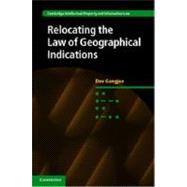
Note: Supplemental materials are not guaranteed with Rental or Used book purchases.
Purchase Benefits
What is included with this book?
| Acknowledgments page | p. vii |
| List of abbreviations | p. ix |
| Table of cases | p. xi |
| Introduction: locating geographical indications | p. 1 |
| The mess: conceptual, institutional and epistemic | p. 2 |
| Controversies and interests | p. 8 |
| Contribution and organisation | p. 14 |
| The Indication of Source - Paris and Madrid | p. 21 |
| Introduction | p. 21 |
| The Paris Convention | p. 23 |
| The Indication of Source | p. 27 |
| The scope of protection: Articles 9 and 10 | p. 41 |
| Alternative possibilities? | p. 52 |
| The Madrid Agreement | p. 65 |
| The scope of protection: Article 1 | p. 65 |
| Generic terms: Article 4 | p. 68 |
| Conclusion | p. 74 |
| The Appellation of Origin in France | p. 77 |
| The significance of the French experience | p. 77 |
| The role of origin in wine regulation | p. 80 |
| A geology of terroir | p. 83 |
| Phylloxera and fraud | p. 93 |
| From the AO to the AOC | p. 96 |
| The Law of 1905 | p. 98 |
| The Law of 1919 | p. 102 |
| The Laws of 1935 and 1947 | p. 108 |
| Doing things differently: Germany and the UK | p. 115 |
| Conclusion | p. 124 |
| The Appellation of Origin in the Lisbon Agreement | p. 127 |
| Introduction | p. 127 |
| The Appellation of Origin: Article 2 | p. 130 |
| The link between product and place | p. 137 |
| Natural and human influences | p. 141 |
| Geographical denomination | p. 143 |
| Reputation | p. 145 |
| International registration and its effects | p. 146 |
| Process of registration | p. 147 |
| Consequences of registration | p. 152 |
| The scope of protection: Article 3 | p. 157 |
| Nominate categories of prohibited uses | p. 158 |
| The general prohibition against usurpation or imitation | p. 162 |
| Absolute protection | p. 172 |
| Conclusion | p. 177 |
| TRIPS today | p. 183 |
| Introduction | p. 183 |
| An outline of Articles 22 to 24 | p. 185 |
| Pathways to TRIPS | p. 191 |
| TRIPS as compromise(d) | p. 192 |
| The WIPO negotiations | p. 195 |
| Compromise and its consequences | p. 199 |
| The definition of a GI: Article 22.1 | p. 213 |
| The sign | p. 215 |
| The goods | p. 216 |
| Region of origin | p. 218 |
| The link between product and place | p. 223 |
| The scope of protection: one definition, yet two levels | p. 237 |
| Generic status | p. 244 |
| The relationship between GIs and trade marks | p. 255 |
| The language of trumps: FITFIR | p. 257 |
| Parma ham and the inequities of FITFIR | p. 259 |
| Descriptive fair use and co-existence | p. 261 |
| Conclusion | p. 262 |
| TRIPS tomorrow? | p. 265 |
| The significance of contemporary debates | p. 265 |
| Extending Article 23 to all products | p. 266 |
| Normative arguments in favour of extension | p. 275 |
| International registration and its effects | p. 288 |
| Conclusion | p. 295 |
| Conclusions - relocating geographical indications | p. 297 |
| Bibliography | p. 303 |
| Index | p. 332 |
| Table of Contents provided by Ingram. All Rights Reserved. |
The New copy of this book will include any supplemental materials advertised. Please check the title of the book to determine if it should include any access cards, study guides, lab manuals, CDs, etc.
The Used, Rental and eBook copies of this book are not guaranteed to include any supplemental materials. Typically, only the book itself is included. This is true even if the title states it includes any access cards, study guides, lab manuals, CDs, etc.